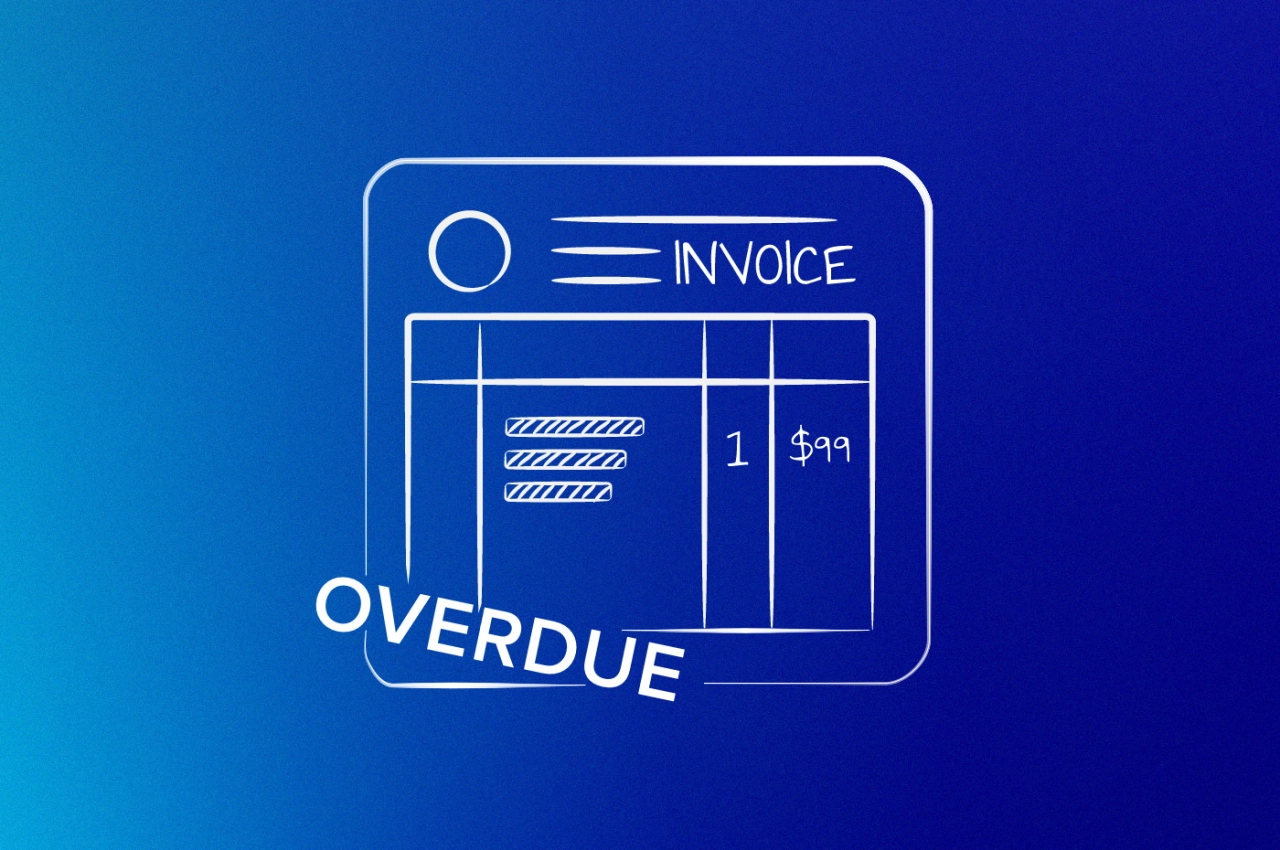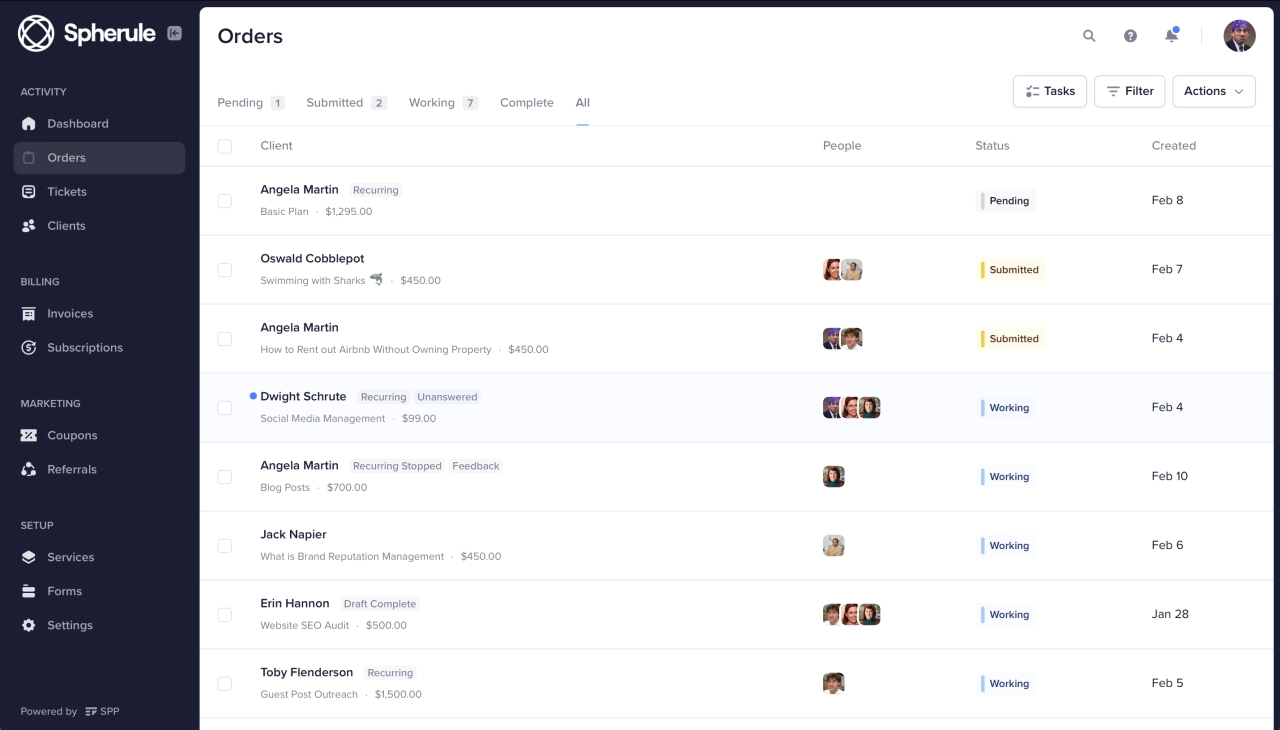- When a client doesn’t pay an invoice, don’t threaten them, post negative reviews, or charge a payment method on file without consent.
- Resend the unpaid invoice and reach out to the client while also pausing ongoing work.
- If the client still cannot pay, you can offer a payment plan, think about taking legal action, or use a collection agency.
When you’re invoicing a client, you don’t expect them not to pay on time. But what if they ignore the invoice and you start facing late payments? Can you take legal action, or is there a better way?
Nobody wants to waste time chasing clients for payment, but if you’ve delivered a service and they refuse to pay, you need to act. In many cases, the clients have simply overlooked the invoice, their card payment failed, or they are confused by the invoice. Simply talking to them and helping them is enough to settle the outstanding payment. If the client is not paying an invoice still, something else is going on.
In this post, I’ll introduce you to different ways you can get clients to pay. But first, here are a few things you should refrain from.
Understanding the impact of unpaid invoices
Unpaid invoices can wreak havoc on a business’s financial health and cash flow. When customers fail to pay their invoices on time, it can lead to a lot of problems. For small business owners, this can mean struggling to cover operational costs, pay employees, or invest in growth opportunities. The ripple effect of unpaid invoices can be profound, affecting not just the bottom line but also the overall stability and reputation of the business.
Impact on your bottom line
The impact of unpaid invoices on a business’s bottom line can be substantial. According to industry research, 49% of invoices issued by US businesses become overdue (PYMNTS, 2022), with some studies reporting even higher rates of late payments., resulting in significant losses.
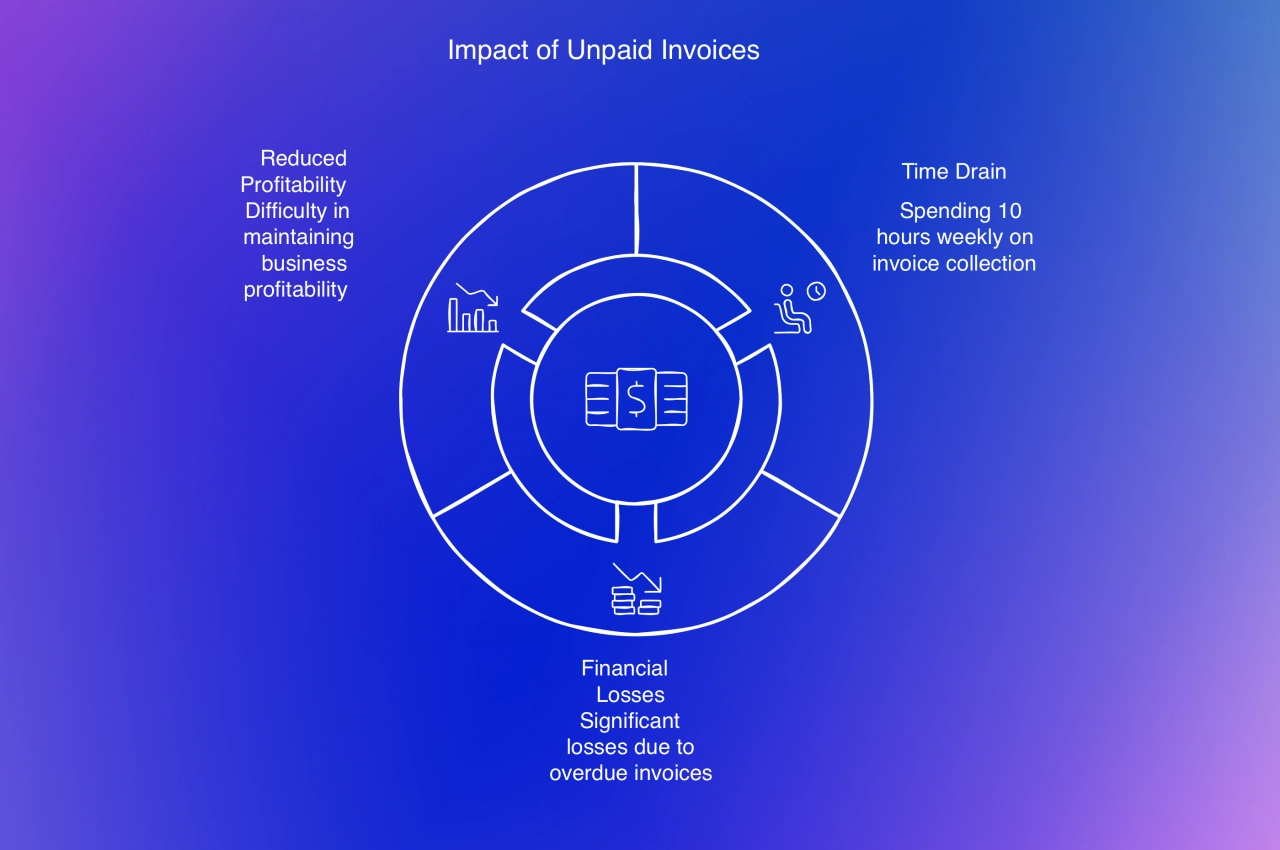
Small to medium-sized businesses spend an average of 14 hours per week handling late invoices according to QuickBooks research, while 31% of businesses dedicate 21-30 hours per month to chasing overdue payments based on a 2023 PayIt survey.The financial strain can also lead to reduced profitability, making it harder for businesses to thrive.
Impact on business health & cash flow
Unpaid invoices can affect a business’s health and cash flow in several ways:
Cash flow problems: Unpaid invoices can lead to cash flow difficulties, making it challenging for businesses to pay their bills, employees, and invest in growth.
Reduced profitability: When invoices remain unpaid, the business is not receiving the revenue it is entitled to, which can significantly reduce profitability.
Damage to reputation: Consistently dealing with unpaid invoices can damage a business’s reputation, as customers may view the business as unreliable or unprofessional.
Preventing non-payments from the start
Preventing non-payments from the start is crucial for businesses. By being proactive, you can reduce the risk of non-payment and ensure that you receive the revenue you’re entitled to.
Drawing from my experience scaling Premier Staff and serving luxury clients like Ferrari and Louis Vuitton, we’ve found that effective invoicing requires a systematic approach that balances client relationships with financial stability. Our most significant challenge emerged when expanding our services, requiring us to develop a comprehensive payment policy that now includes 100% upfront deposits for most clients and minimum 50% deposits for established businesses.
 Daniel Meursing,
Premier Staff
Daniel Meursing,
Premier Staff
Here are some strategies to consider:
Payment terms: Ensure that your payment terms are clear and agreed upon before starting any work. This includes specifying due dates, late fees, and acceptable payment methods.
Upfront payments: For larger projects, consider asking for a portion of the payment upfront. This not only secures some revenue but also shows the client’s commitment.
Follow-ups: Implement a system for regular follow-ups on outstanding invoices. This can be automated through your invoicing system to ensure no invoice slips through the cracks.
Early payment discounts: Offer discounts for early payments to incentivize clients to pay their invoices promptly.
Invoicing for an agency can be a headache, especially when clients have different expectations about payment terms or the scope of work. One challenge I’ve faced is clients delaying payments or questioning charges. To prevent this, I make sure contracts are as clear as possible from the start—outlining milestones, deadlines, and what’s expected at each stage. That way, both parties are on the same page.
 James Hacking,
Socially Powerful
James Hacking,
Socially Powerful
By implementing these strategies, youcan significantly reduce the risk of non-payment and maintain a healthy cash flow.
3 invoice collection mistakes that backfire
I get it, you just want to get paid for the service you’ve provided. It can be frustrating when you send invoices but don't receive payments. In any case, the right way to handle such situations is by keeping calm.
So here are a few things you should never do when your clients don’t pay:
Threaten them: If a client refuses to pay, threats are rarely effective. Instead, try to find a middle ground. Are they struggling with money right now or are they unhappy with the services provided? If it’s the former, try to find a solution (I propose one further below).
Post negative reviews: If it’s a B2B client, chances are high that they have an online presence, be that on social media or a website such as TrustPilot. Before you decide to post a negative review, make sure that you’ve exhausted all your options first. If the company is indeed unprofessional and is refusing to pay for your services, it makes sense to let others know about it so they don’t have the same experience.
Charge a payment method: You think it makes sense to simply charge a saved payment method—and yes, you can do that as a last resort. However, with credit and debit cards, there’s a high chance that your client will file a chargeback request with their bank. This will cause extra work for you as you’ll have to submit evidence, you might still lose the case, and it’ll affect your good standing with the payment processor.
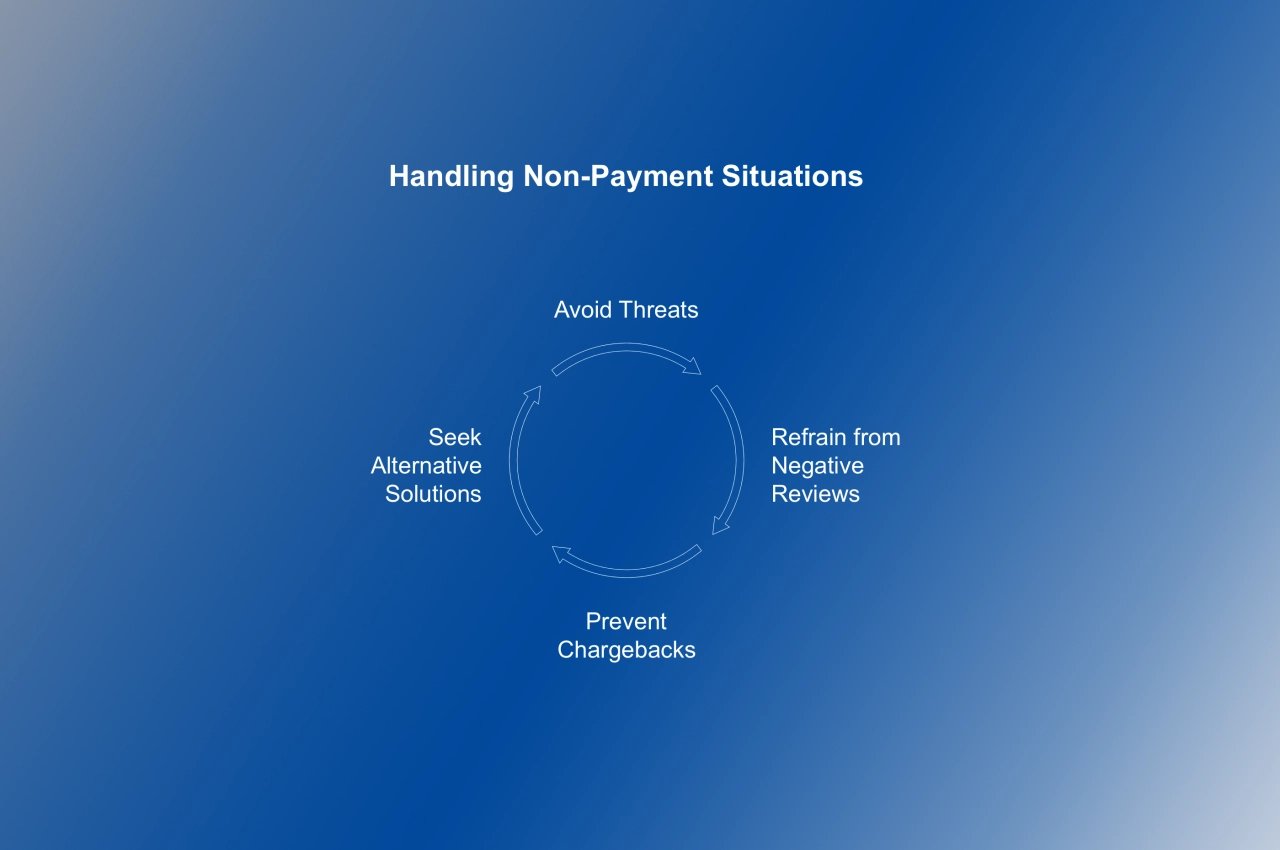
So, instead of resorting to the three things mentioned above, here are safer ways to get customers to pay.
Is the client disputing the invoice?
Chasing invoice payment is not fun for anyone. You lose time and money doing so, plus it puts your liquidity in jeopardy.
An unpaid invoice can be even more problematic if the client isn’t planning on paying it at all. Some clients are disputing invoices—and for a variety of reasons. Maybe they found an invoicing error, or they are not happy with the services rendered. Whichever case it is, you should have a process in place to solve this issue quickly.
If that’s not the case, then you can jump to the next point.
How to follow up on unpaid invoices
Before you decide to jump the gun and invoice a debt collection agency or small claims court, assume that it was an innocent mistake. Simply resend the invoice and see what happens. Maybe the email ended up in the client’s spam folder, or they were out of office and missed it.
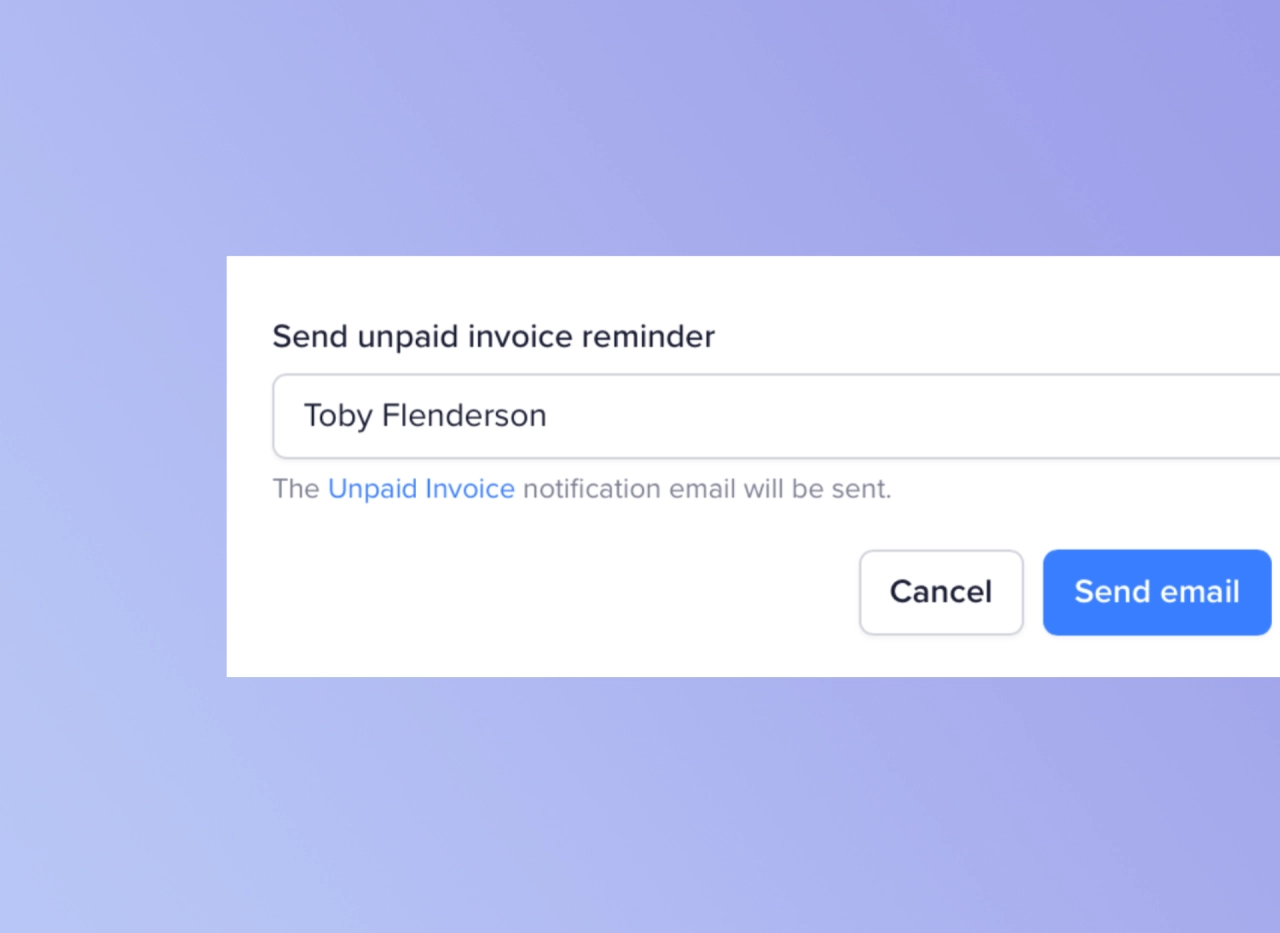
Send unpaid invoice email reminder
Tip: If you need some inspiration on how to write the unpaid invoice reminder emails, check out this post.
Otherwise, simply email the client manually, remind them of the unpaid invoice (including the outstanding amount and due date), and attach the invoice for their reference.
Call non-paying clients (script included)
If step one has not been successful, reach out to the client. This can be via email, phone, social media, or any other contact method available to you. There’s a good chance they are not seeing your emails, either because they ended up in spam or their inbox is simply overflowing. Theoretically, your subject should be clear enough for them to notice that they need to make a payment.
In any case, try your luck via phone, SMS or WhatsApp if you’re not receiving replies via email. The next goal is to get the non-paying client to respond to you—in any way possible. Once they do, notify them about the outstanding payment, and ask them to pay it as soon as possible.
Phone script for non-paying clients
Opening (friendly but direct):
Hi [Client Name], this is [Your Name] from [Company]. I hope you're doing well. I'm calling about invoice #[Number] for $[Amount] that was due on [Date]. I wanted to reach out personally to see if there are any issues on your end that might be preventing payment.
If they forgot/overlooked:
No problem, these things happen. Can you process the payment today? I can wait on the line while you handle it, or would you prefer I send the invoice again?
If they’re having cash flow issues:
I understand cash flow can be challenging. Would a payment plan work better for you? We could split this into [2-3] payments over the next [30-60] days. What would work best for your situation?
If they dispute the work/invoice:
I want to make sure we resolve this properly. Can you walk me through your specific concerns? Let's schedule a time this week to review the details and find a solution that works for both of us.
Closing (document & nNext steps):
Great, so to confirm: [restate agreement]. I'll send you a follow-up email summarizing what we discussed and the next steps. Thank you for taking the time to talk this through with me.
If they don’t answer:
Hi [Name], this is [Your Name] from [Company] calling about invoice #[Number] due on [Date]. Please give me a call back at [number] so we can resolve this quickly. Thanks.
Pause services until payment received
If you’re working on a long-term project and the client owes you money, you should pause your service until the late payment is taken care of. Your cash flow is already affected by the outstanding invoice, but now you should also reduce any risks when it comes to doing more unpaid work.
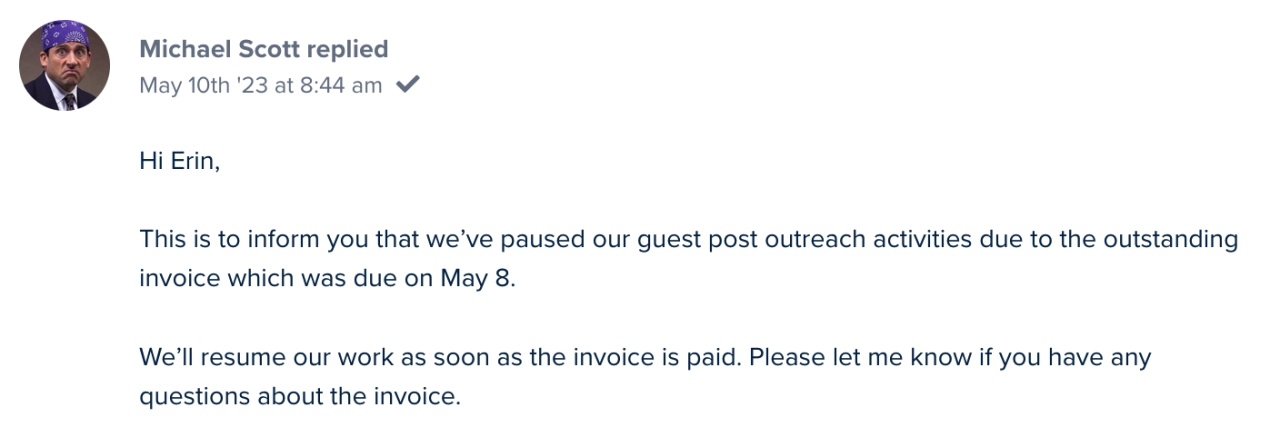
It’s also a good idea to inform the client that you’ve paused your work until they pay your invoice. Once they do, you can resume the project.
Agree on a payment plan
If a client doesn’t pay because they are financially in trouble, it’s still in your interest to help them out in any way you can. And the easiest one is to set up a payment plan. From my freelancing days, I learned that clients who communicate about payment issues are usually worth working with—they just need some flexibility.
You can agree to split up the payment into multiple installments spread out over an agreed upon period. Here are three proven templates I’ve used successfully:
Payment plan templates
Option 1: 30-60-90 day plan (most common)
Month 1: 50% of outstanding amount
Month 2: 30% of outstanding amount
Month 3: 20% of outstanding amount
Include 1.5% monthly service fee after first month
Option 2: Weekly payment plan (for smaller amounts)
Week 1: 40% of outstanding amount (due immediately)
Weeks 2-5: 15% each week
Best for amounts under $5,000
Option 3: Project-based split (for ongoing work)
60% of current outstanding invoice
40% added to next project as upfront deposit
Resume work only after first payment clears
Payment agreement essentials
Make sure to have this agreement in writing, and include these key points:
Specific payment amounts and dates (not just percentages)
Late fees for missed installment payments (I recommend 2-3%)
Acceleration clause (full balance due if they miss a payment)
Work suspension terms (you can pause services for missed payments)
Contact requirements (they must notify you if they’ll be late)
Sample payment agreement language:
Outstanding invoice #[Number] totaling $[Amount] will be paid as follows: $[Amount] due [Date], $[Amount] due [Date], $[Amount] due [Date]. A 2% monthly service charge applies to missed payments. If any payment is more than 7 days late, the full remaining balance becomes immediately due.
Payment plan best practices
Don’t spread out the payment plan over more than six months—. ’ve found longer plans rarely work out. Ideally, ask the customer to make the first partial payment right away. This shows good faith and gives you something immediately.
Red flags to avoid:
Clients asking for plans longer than 6 months
No upfront payment or deposit
Vague language about when business picks up
History of missing previous payment deadlines
If they agree to a payment plan but miss the first installment, don’t extend it further. At that point, it’s time to move to collection agencies or legal action.
Take legal action
In rare cases, and if the outstanding amounts are considerable, it makes sense to take legal action against a client. This is especially true if the client is another company.
Before you do, though, do a cost analysis. Is it worth it hiring an attorney, or will the costs for hiring one outweigh the outstanding amount? Otherwise, it’s better to note down what has happened, and think about ways to avoid it in the future.
Getting involved with a small claims court is not a walk in the park, on the contrary. You need to file a complaint, prepare and present your case, and finally wait for a judgement. Unless the amount is in the thousands, it’s simply not worth the effort. Plus, in some states in the U.S., you cannot ask a lawyer to represent you. And I’m not even going into the fact that your client could be located overseas, which makes taking legal action even more complicated.
Use a collection agency
If initial reminders and follow-up calls fail to produce results, consider sending formal debt collection letters as an escalation measure. These written communications clearly notify the debtor of the overdue payment and provide a paper trail for any future disputes or negotiations.
If you’re still not seeing results, you can make use of a collection agency. While industry-wide collection success rates vary significantly depending on the type of debt and client circumstances, B2B commercial debt typically performs much better than consumer debt. Specialized commercial collection agencies often achieve substantially higher recovery rates for viable business claims. Some agencies report success rates of 85% on larger commercial accounts where the business is still operating. The key difference is that businesses are generally more responsive to professional collection efforts than individual consumers, making B2B debt significantly easier to recover than consumer debt.
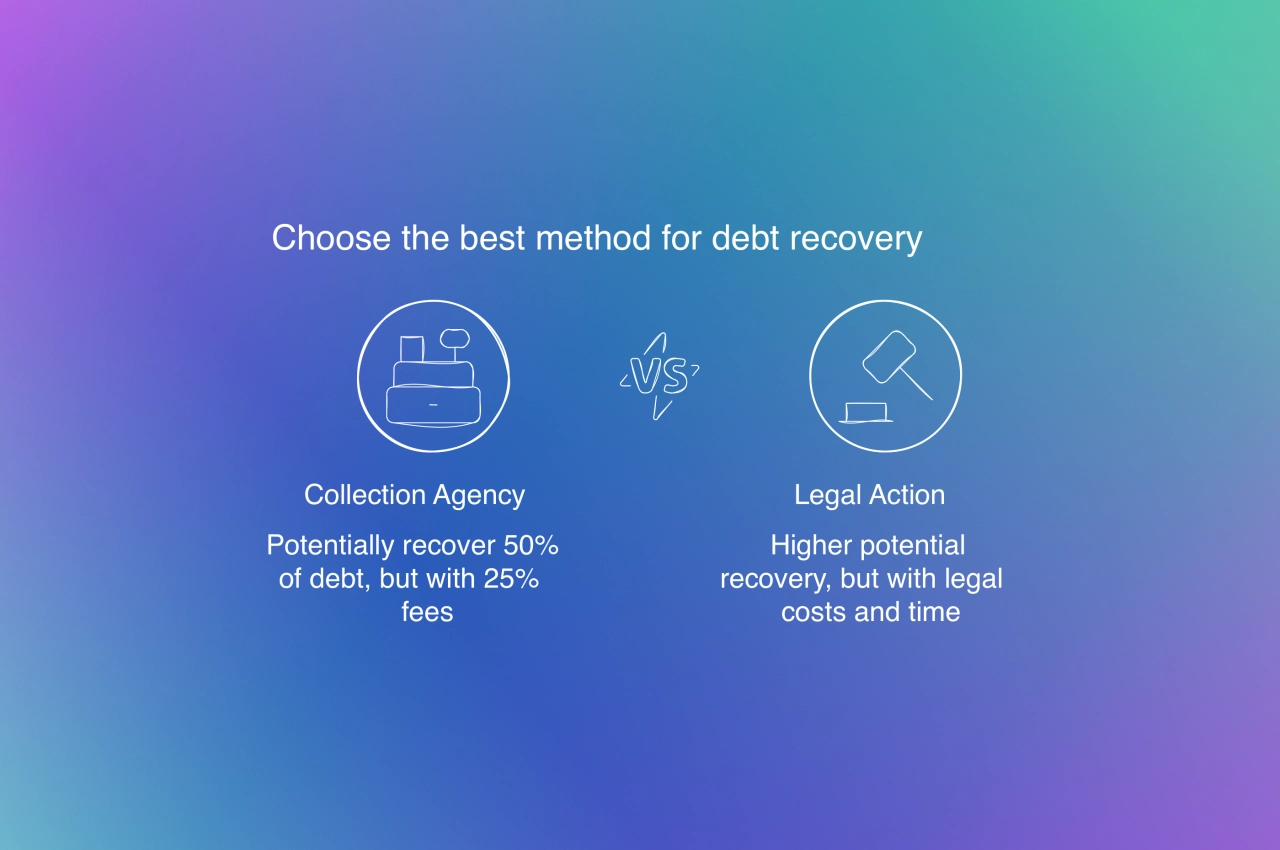
Another thing to keep in mind that the fees of a collection agency on the amount collected can be up to 25%. Assuming they recover 50% of $10,000 owed, you only receive $3,750. Is it better than nothing? Probably, but it’s up to you to make this decision. For larger outstanding payments, hiring a collection agency can be a good choice, especially if it’s clear that the client is hesitant to pay the invoice.
Frequently asked questions
How long should I wait before chasing a late invoice?
I typically recommend waiting 3–5 days past the due date before sending your first reminder. Don't wait too long—the longer you wait, the harder it becomes to collect. From my freelancing days, I learned that clients who pay after 30 days overdue are 50% less likely to pay at all. Set up automated reminders in your billing system so you're not manually tracking every invoice.
Can I charge interest on overdue invoices?
Yes, but only if it’s clearly stated in your contract or invoice terms. Include a late fee clause—something like “2% monthly service charge on overdue balances.” Just make sure you’re consistent about applying it. If you let some clients slide, it weakens your position with others.
What’s the success rate of collection agencies?
For B2B debt, collection agencies typically recover 15–28% of what you’re owed, and they’ll take 25–40% of whatever they collect. So if you’re owed $10,000, you might get back $1,500–$2,800 after fees. That’s why I always recommend exhausting other options first—direct communication, payment plans, and pausing services usually work better for service-based businesses.
Is it legal to stop work for unpaid invoices?
Absolutely, and you should. I learned this the hard way as a freelancer—continuing work while chasing payment just digs you deeper into the hole. Always include a clause in your contract that allows you to pause services for non-payment. Just make sure to notify the client in writing when you’re pausing work and why.
Can I charge a credit card on file without permission?
Technically yes, if your terms of service allow it, but I don’t recommend it. Clients can easily dispute the charge with their bank, and you’ll likely lose the chargeback case. Plus, it damages the relationship. It’s better to contact them first and get explicit permission to process the payment.
Summary
There are many reasons why clients don’t pay, but whatever they are, it’s in your interest to find a solution. With the above-mentioned steps to take when invoices remain unpaid, you have multiple ways of dealing with this unpleasant scenario.
If a client continues to pay their invoices late, consider to charge them late fees. You can also ask for payments upfront for certain services, especially those that are on the higher end. I also keep recommending in my blog posts to switch to recurring services that are billed automatically.
You can integrate your SPP client portal easily with Stripe or PayPal and stop worrying about past due invoices. If you’re not sure how to get started, read this post on how to integrate a payment gateway into your website.
Disclaimer: This article provides general business guidance and is not intended as legal or financial advice. Debt collection laws vary by jurisdiction. Before taking legal action or implementing collection procedures, consult with qualified attorneys or business advisors licensed in your area. Individual results may vary.
